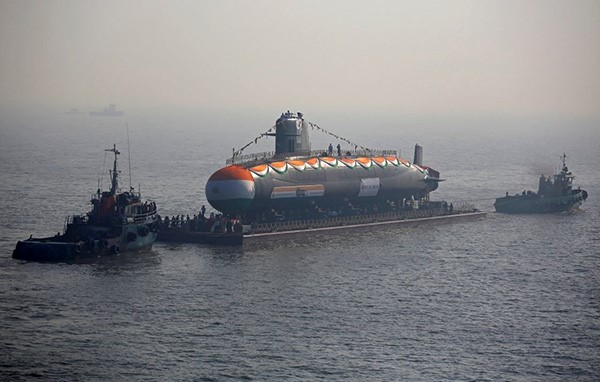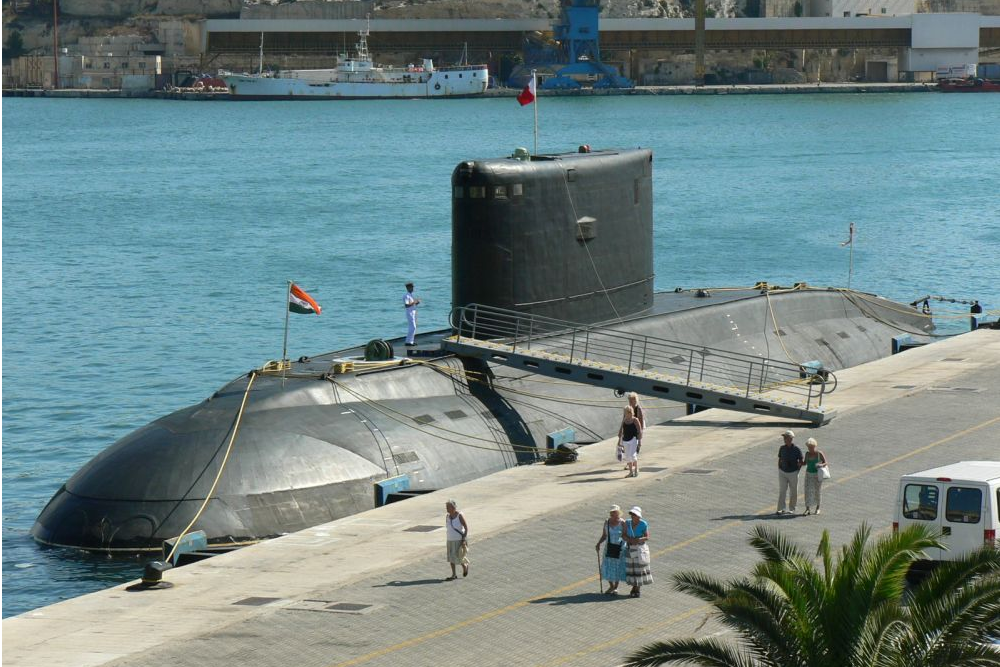India’s new submarine procurement plan is on the verge of bankruptcy, and "dominating the Indian Ocean" encounters multiple challenges.
India is bidding for the purchase of six new submarines, which will be equipped with AIP system (independent of aerodynamic force) and further enhance their combat effectiveness, but this procurement plan is currently on the verge of bankruptcy.
According to Sputnik news agency & radio’s report on February 16th, the Indian National Defense Research Institute said that India’s AIP (Aerodynamic Independent Unit) submarine procurement plan was on the verge of bankruptcy, because five of the six foreign companies that participated in the bidding had given up bidding.

Calvari-class submarine to be launched, which was developed from the French Tuna-class submarine.
Why do many countries withdraw from Indian submarine bidding?
On July 20th last year, the Indian Ministry of Defence put forward the "75I" project (P-75I) to continue to build six advanced conventional submarines in India, and asked these advanced conventional submarines to install "AIP". India has sent invitations to Japan, Germany, France, Spain, South Korea and Russia.
The bidding for these six new submarines is part of the Indian Navy’s plan to consolidate its strength as the first underwater force in the Indian Ocean, but this ambition to enhance its underwater combat power has encountered new setbacks.
The Indian National Defense Research Institute pointed out that six foreign companies participated in the bidding for the "75I" project, and five of them have given up bidding. ThyssenKrupp Marine Systems (TKMS) of Germany and SAAB of Sweden withdrew from the bidding because of difficulties in the transfer of key technologies and intellectual property. The French Naval Group, the Russian Defense Export Corporation and the Spanish shipbuilding company Navantia withdrew due to the lack of mature technology in the research and development of aerodynamic devices.
Only South Korea’s Daewoo Shipbuilding and Ocean Engineering Company’s solution based on the KSS-II submarine is more realistic. However, India’s defense procurement procedures prohibit bidding when only one supplier participates.
The Indian National Defense Research Institute pointed out that the only country that can participate in the bidding may be Japan, which has been building its own AIP submarine. India had invited Japan to participate in the bidding before, but Japan refused.
India’s "Economic Times" said on the 14th that a spokesman for the Russian Defense Products Export Corporation said, "Russia has previously confirmed its interest in participating in the project, and proposed to adopt the project based on 677E(‘ Amur ’ Type) platform for submarine project design. However, after receiving and studying the final terms and conditions of the Indian tender, Russia decided not to participate in the bidding for technical reasons. " However, the Russian side said that the Indian navy has long been a loyal user of Russian submarines. In order to strengthen the Indian submarine fleet, Russia is willing to continue to provide maintenance and upgrade services for Russian submarines.

Kilo-class submarine equipped by the Indian Navy.
According to previous reports from Indian media, the "75I" project is estimated to cost 5.75 billion to 6.47 billion dollars. According to the requirements of the project, in addition to the six submarines listed in the project, the Indian Navy reserves the option of "manufacturing six more submarines according to the project".
Li Jie, a naval expert, told The Paper that the "75I" project was a follow-up to the "Program 75", a submarine procurement project of the Indian Navy. The tuna class submarine of the French military enterprise finally won the tender for the "75" project, and the tuna class submarine built in India was named "Calvari" class submarine and the first boat was "Calvari".
Compared with tuna-class submarines, the six submarines purchased by the Indian Navy for the "75I" project will be equipped with AIP system and vertical launch system, and their operational performance will be greatly improved.
“‘ 75I’ In fact, the project has been proposed for nearly 10 years, but the international bidding time has been delayed repeatedly, mainly because there are many differences within India, India and foreign companies participating in the bidding in terms of project funds and technology transfer. " Li Jie said.
After the tender for the "75I" project was launched, it was widely analyzed that since India has introduced six French tuna class submarines and France has lost the order for Australian submarines, it is bound to be very concerned about the new tender, so the tuna class scheme equipped with AIP system is likely to win. However, from the current news, France has also withdrawn from the bidding.
"France has successfully developed an AIP system with a closed-cycle steam turbine and exported it to Pakistan, but this system has many shortcomings. In addition, it has been exported to Pakistan, and India will not choose this system," Li Jie told The Paper. "Although the second-generation AIP system developed by France uses fuel cells to keep up with the trend, the technology is not mature enough to meet India’s requirements, and France can only withdraw from the bidding."
In Li Jie’s view, Modi has always emphasized Indian manufacturing, hoping that foreign companies will transfer more submarine technology, which is one of the important reasons why foreign companies give up bidding, because these foreign companies rely on some core technologies of submarines to make money and transfer them to India. In the future, there may be a situation of "teaching apprentices and starving masters".
Foreign companies have withdrawn from the bidding of the "75I" project, and the procurement plan of this project will face the result of bankruptcy. The Indian National Defense Research Institute said that what India can do is either to modify the technical conditions of the plan or to compromise on technology transfer.

The attack nuclear submarine leased by India from Russia belongs to the "Akura" class nuclear submarine.
India’s ambition to expand submarine strength has been frustrated.
The bidding for the "75I" project is likely to end in vain, and the most direct impact is that the upgrading plan of the Indian navy’s underwater forces cannot be carried out smoothly.
According to the Times of India, according to the current plan, the Indian navy can only get three new submarines in the next decade, but it will eliminate at least four old submarines. According to the consistent procrastination of Indian military procurement, it will take many years to sign a contract, plus technology transfer, submarine construction and sea trial work. "Even the most optimistic assessment, the first new submarine cannot be delivered before the end of 2020s."
At present, the Indian Navy’s 15 conventional submarines in active service include eight 877 Kilo-class submarines, four 209-class submarines and four Calvari-class submarines. In the future planning of conventional submarine forces, both Type 877 and Type 209 submarines will be retired and replaced by 6 Calvari class submarines and 12 new submarines built under the "75I" project.
According to Indian media reports in April last year, the Indian Navy is planning to build as many as 24 new submarines. In the report submitted by the Indian Navy to the country’s parliament, it is pointed out that the service life of Indian conventional submarines is more than 25 years. In the next boat-building plan, India will build 18 conventional submarines and 6 attack nuclear submarines.

In view of the fact that India has introduced six French tuna-class submarines, it was widely believed that France was the most likely to win the tender for the "75I" project.
"India has been the country with the largest number of submarines along the Indian Ocean for a long time, but now the number of countries with submarines around India is increasing. Some countries are also expanding their submarine forces, and some countries are also preparing to build nuclear submarines. India feels that the challenges it faces are increasing, so it is also eager to expand the submarine strength and consolidate the position of the first underwater strength in the Indian Ocean." HanDong, a military expert, analyzed that.
In September last year, the leaders of the United States, Britain and Australia proposed to establish a trilateral security partnership called "AUKUS" at the tripartite meeting. The first task of the three-nation security partnership is that the United States and Britain should provide Australia with a nuclear-powered submarine force. For this reason, Australia cancelled the previous agreement with France on 12 "short-fin barracuda" AIP submarines and sought to build eight attack-type nuclear submarines instead.
Pakistan, India’s arch-enemy, is also expanding its submarine force. At present, the Pakistani navy has five submarines, including three agusta -90B and two agusta -70B submarines. In July 2015, Pakistan officially purchased eight conventional power submarines, four submarines will be delivered to the Pakistan Navy between 2022 and 2023, and the other four submarines will be built by the Pakistan Shipyard, and all of them will be delivered to the Pakistan Navy by 2028.
"For the Indian Navy, the challenge of consolidating the first position of strength comes not only from the outside world, but also from the delay in bidding for new submarines and the aging of active submarines." HanDong pointed out.
At present, the Indian navy has planned to upgrade six old submarines to maintain the combat capability of underwater forces.
The nuclear submarine is also not optimistic, and the Indian navy is currently experiencing the situation that the attack nuclear submarine is "broken". Last June, chakra, India’s only active attack nuclear submarine, was photographed in the Straits of Malacca. People familiar with the matter said that the final destination of the submarine was Vladivostok, Russia, where it was returned to Russia. In 2012, India spent $1 billion to lease the submarine to Russia for 10 years.
According to the lease, India should return the submarine "chakra" in April this year, but sources told New Delhi TV that India had to return the submarine ahead of schedule because of the "increasingly unreliable power and maintenance problems" of the ship.
In order to continue to own attack-type nuclear submarines, India has signed a $3 billion agreement with Russia in 2019, and will lease another Akura-class nuclear submarine for 10 years. The boat will be renamed as "chakra 3" and will be delivered to the Indian Navy around 2025. This means that in the next three years, there will be a vacuum in the Indian navy’s attack nuclear submarine force.